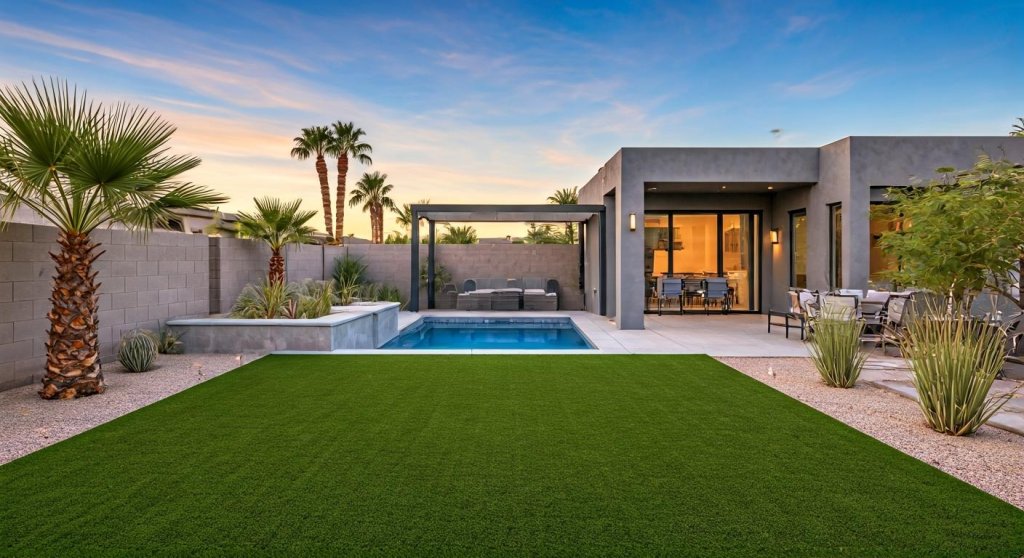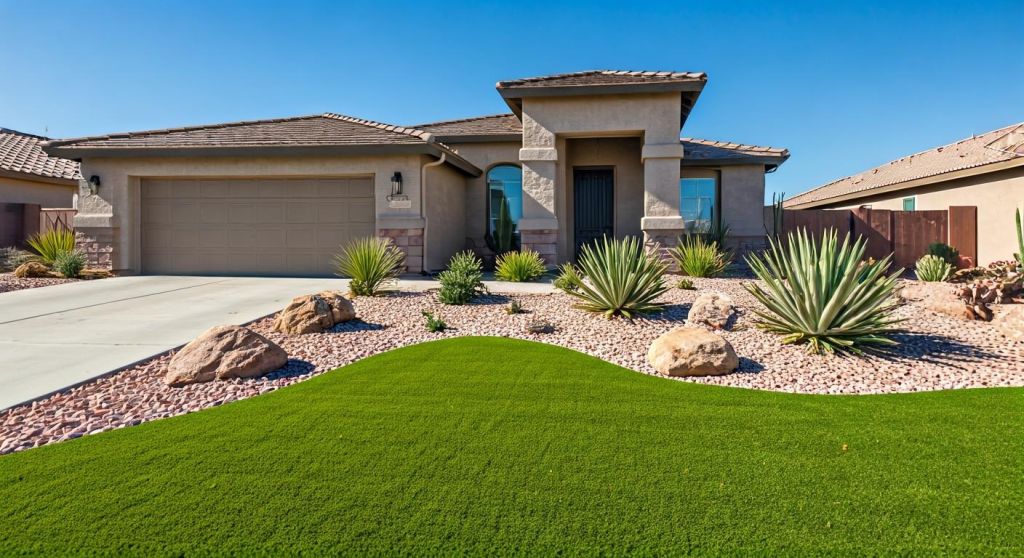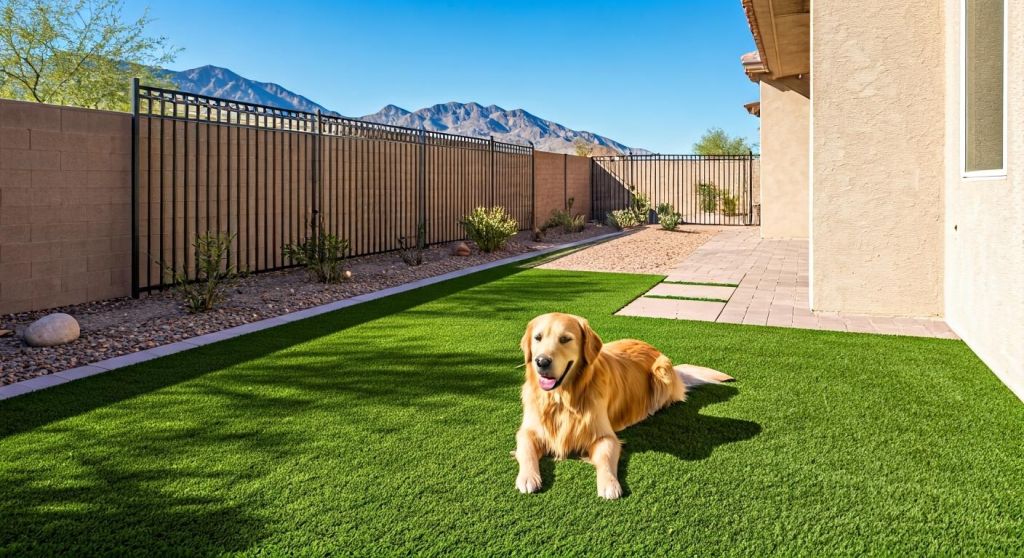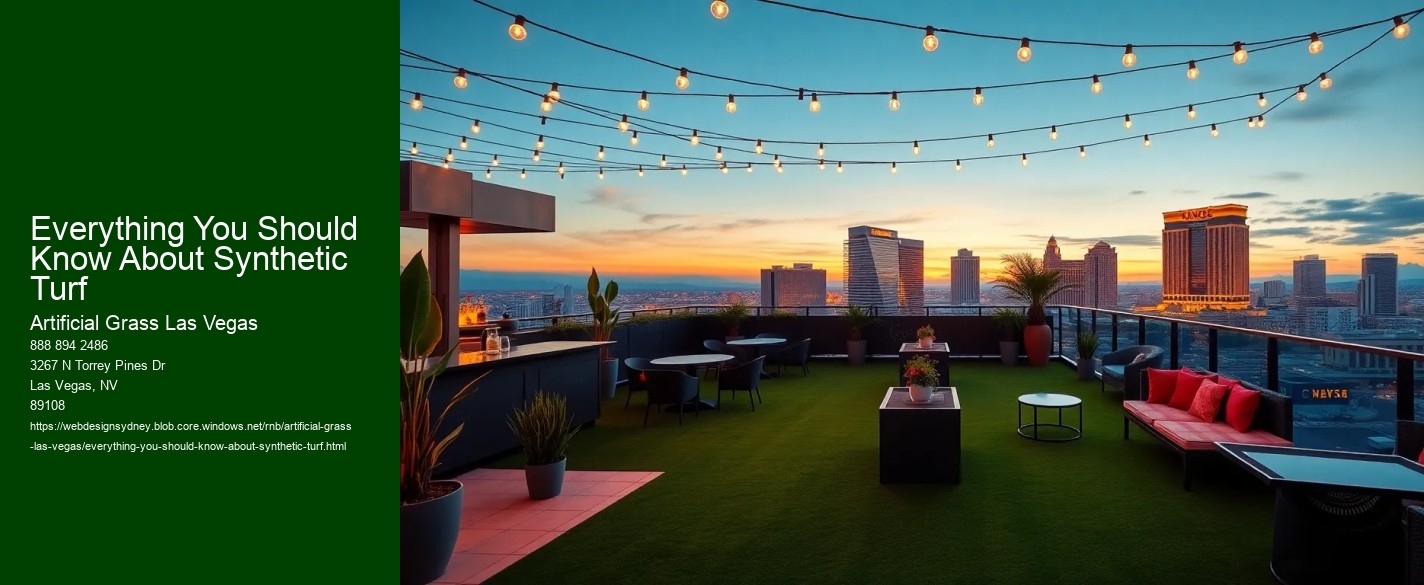What is Synthetic Turf and How Is It Made?
Synthetic turf, you mightve heard of it, is that artificial grass that seems to be popping up everywhere these days! Quality Artificial Grass Vegas Nevada. Its not just a pretty fake lawn though, its actually a high-tech solution for places where maintaining real grass can be a hassle or downright impossible. So how do they make this stuff? Well, its a bit of a process!
First off, they dont use any actual grass, which comes as a surprise to some people. Instead, synthetic turf is made from a blend of plastic fibers, usually either polyethylene or nylon. These fibers are then cut to mimic real grass blades, giving them that familiar green color and sometimes even a subtle texture. But heres the thing, its not all about looks - theres also a backing material involved.
This backing, oh boy, its crucial for keeping the turf in place. Its usually made from rubber (yes, rubber - think old tires) or a mix of rubber and plastic. The backing provides stability and helps the turf stay flat and secure. And guess what? They add a layer of sand or rubber infill between the fiber blades and the backing to give it that realistic bounce and to keep the grass standing upright. Without this step, youd end up with a bunch of floopy strands on the ground!
Now, you might wonder why anyone would choose synthetic turf over the real deal. Well, for starters, it doesnt require watering, mowing, or fertilizing. Thats right, no more dealing with stubborn weeds or patchy spots. Also, it can last much longer than regular grass if its taken care of properly. But hey, not everyone loves it. Some folks argue that it lacks the natural beauty and scent of real grass, and it can get pretty hot underfoot during summer months.
So there you have it! Synthetic turf isnt just a fancy way to cover your lawn; its a whole different approach to outdoor spaces. Just remember, its not for everyone, but for those who need a low-maintenance option, it can be a lifesaver!
Benefits of Synthetic Turf Installation
Alright, so when it comes to synthetic turf installation, there are some serious benefits that can make a huge difference in how you use and enjoy your outdoor spaces! First off, you don't have to worry about mowing every week, which honestly is a huge relief! And it's not just about avoiding the chore; synthetic turf looks fresh and green all year round, regardless of the weather. No more brown patches or yellowing grass, even during those hotter, drier months.
Another big win is its durability. Unlike regular grass, synthetic turf can handle a lot of wear and tear. Whether you have kids who love to play soccer or dogs that love to run around, synthetic turf can take it all without going bald or getting damaged. It's like having a built-in, low-maintenance play area for your family and pets.
And let's not forget about water conservation. In areas where water usage is a concern, synthetic turf is a no-brainer. You won't have to water it, fertilize it, or use pesticides, which not only saves water but also reduces your environmental impact. It's a win-win situation!
But it's not all sunshine and rainbows. There are some drawbacks, like the initial cost of installation, which can be quite high. And while it's low maintenance, it's not completely maintenance-free. You still need to clean it occasionally to keep it looking good. But hey, compared to the hassle of maintaining a real lawn, it's a walk in the park!

All in all, synthetic turf installation can bring a lot of benefits to your outdoor space. Las Vegas Artificial Lawn Installers It's perfect for busy families, pet owners, and anyone who wants to spend more time enjoying their yard without worrying about grass care. So if you're thinking about an upgrade, give synthetic turf some serious consideration!
Different Types of Synthetic Turf Available
When it comes to synthetic turf, many folks might think it's all the same. But, oh boy, there are actually different types available that cater to various needs and preferences! Not only is synthetic turf a great alternative to natural grass, but it also comes in a variety of styles, textures, and purposes.
First off, let's talk about the most common type: the general-purpose turf. This is what you'll often see in residential backyards or playgrounds. It's designed to be durable and withstand heavy foot traffic, making it perfect for kids playing or pets running around. However, it's not always soft enough for those who want a more luxurious feel underfoot.
Then, we have the sports turf, which is specifically engineered for athletic fields. This type is crafted to mimic the feel of real grass while providing the necessary traction for sports like soccer, football, or baseball. It's usually made with a higher pile height (that's the length of the grass blades) and has a denser construction, so it can handle the wear and tear from athletes. You wouldn't want your turf to get worn out too quickly, right?
Next up is the landscaping turf, which is often used in decorative areas or around pools. This type tends to have a more realistic appearance and is designed to enhance the aesthetic appeal of a space. It's often softer and comes in various shades of green, giving that lush look without the hassle of maintenance. Plus, it doesn't require mowing, so you can spend your weekends relaxing instead of working in the yard!
Lastly, there's pet turf, created with furry friends in mind. It's designed to be more resistant to odor and easier to clean, which is a big plus for pet owners. Some pet turfs even have built-in drainage systems to make cleanup a breeze. You definitely don't want to deal with messes, do you?
In conclusion, whether you're looking for something durable for sports, soft for your kids, beautiful for landscaping, or practical for pets, there's a synthetic turf type out there that'll meet your needs. So, don't just settle for any old grass (or turf)! Explore the options and find the perfect fit for your space. You'll be glad you did!
Synthetic Turf Installation Process
Hey there! So, you wanna know all about putting in synthetic turf? Its quite a process, but dont worry, Ill break it down for ya in a way thats easy to understand.

First things first, you gotta measure the space where you want the turf to go. This might sound obvious, but trust me, skipping this step can lead to a whole bunch of problems later on. You need to get the dimensions just right to make sure you order enough material without buying too much.
Next, comes the site preparation. This is where you clear out all the grass, weeds, and rocks from your chosen area. Its a bit like tidying up your room before getting new furniture. If you dont do this properly, your turf wont look as neat as it should, no matter how nice it is.
After the areas all clean, youve got to lay down some sand or rubber infill underneath the turf. This helps with drainage and gives the turf some cushioning. Believe it or not, you cant just plop the turf down on top of dirt and expect it to last!
Then, the actual installation begins. You start by laying down sections of turf, kind of like pieces of a puzzle. But heres the thing: you cant just stick them together willy-nilly. Each piece needs to be cut precisely to fit the space, and you gotta make sure theyre all aligned nicely.
Now, comes the stretching part. This is where you take each section of turf and stretch it out to make it lie flat and smooth on the ground. Its a bit like when youre trying to put on a tight t-shirt – you need to pull and stretch to get it just right!
Once the turfs all laid, you need to secure it with stakes or pins. These help keep the edges from curling up and make sure everything stays in place. Without these, your turf could end up looking like a wrinkled blanket instead of a lush green field!
Finally, you add more infill on top of the turf. This helps to blend the fake grass with the underlying layer, making it look more natural. Its also important for foot comfort and for keeping the turf from matting down over time.
And there you have it! The whole synthetic turf installation process. Its not exactly rocket science, but it does require some patience and attention to detail. Just remember, doing it right the first time saves you a lot of hassle down the road!

Maintaining Your Synthetic Turf
Okay, so youve got synthetic turf, awesome! But dont think its totally maintenance-free, ya know? Maintaining your synthetic turf isnt, like, rocket science, but it is pretty important if you want it to look good and, well, last.
First things first, get yourself a good brush. Artificial Grass For Sports Fields Las Vegas A stiff-bristled, non-metal one is what youre after. You'll wanna brush against the grain of the fibers every so often (maybe once a week, depending on how much you use it), to keep them standing up and looking perky! Thisll prevent that matted-down, sad-looking turf vibe, yikes.
Then theres debris. Leaves, twigs, the random stray wrapper... just pick em up! You dont wanna let that stuff decompose and create a breeding ground for weeds or, even worse, mold. A leaf blower is your friend here, too, for bigger areas.
Spills? Oh boy, they happen. Immediately blot them up with a clean cloth and then rinse the area with water. For tougher stains (pet accidents, greasy stuff, etc.), use a mild detergent mixed with water. But dont use harsh chemicals! They can damage the fibers and nobody wants that.
Talking of pets, pet waste is a major thing. You cant just ignore it. Scoop it up, rinse the area thoroughly, and consider using a turf deodorizer designed for pet waste. Believe me, your nose will thank you.
And finally, infill. Over time, it can settle or get compacted. Youll need to redistribute it occasionally. A power broom or even a lawn rake can help with this. Just spread it around evenly to keep the fibers supported and the surface level.
It really aint that hard, and a little regular care goes a long way. Ignoring it is just gonna lead to problems later on, so just do it!
Cost Considerations for Synthetic Turf
Cost considerations for synthetic turf can be a bit tricky! First off, dont think its gonna be cheap - installing a synthetic lawn can set you back quite a bit. Artificial Grass For Balconies Las Vegas But hey, its not all doom and gloom. The initial expense might be high, but you wont have to worry about paying for grass seed every year or spending hundreds on fertilizer. Plus, theres no need for frequent watering, which can save you a ton of money over time.
Now, lets talk about the negatives. One major cost factor is maintenance. While synthetic turf doesnt require as much care as a natural lawn, it still needs occasional upkeep. Youll have to clean it and inspect it for wear and tear, and that can add up. Not to mention, if something does go wrong, repairs can be expensive.
Another thing to consider is the lifespan of the turf. Its not like a real lawn where you just replant when needed. When your synthetic turf reaches the end of its life, you pretty much have to rip it out and start over. That can be a costly undertaking, especially if youre doing it yourself.
But heres the kicker - some people swear by the longevity and durability of synthetic turf, arguing that the upfront cost is more than worth it in the long run. So, while its not exactly budget-friendly at first glance, it might actually save you dough in the grand scheme of things. Oh well, guess it depends on who you ask!
Common Misconceptions About Synthetic Turf
Okay, so, synthetic turf, right? Its not just that fake grass stuff you see at mini-golf. There are a ton of, like, common misconceptions floating around. Lets debunk a few, shall we?
First off, a lot of folks think its super-low maintenance. Not exactly! Yeah, you dont gotta mow, but that doesnt mean you can completely ignore it. Youve got to, yknow, sweep away debris (leaves, twigs, the occasional rogue tennis ball!), and occasionally give it a good ol rinse to prevent odors, especially if you have pets (Oh dear!). It isnt a "set it and forget it" situation.
Another one is that it looks, well, totally fake. Which, I mean, can be true if you buy the cheap stuff. But! With advancements in tech, there are really realistic-looking synthetic turfs out there. They even have different blade shapes and colors to mimic natural grass. So, dont assume itll look like a plastic carpet (unless you want it to, I guess?).
And then theres the heat thing. People worry it gets super hot. And, yes, it can get warmer than natural grass. However, there are ways to mitigate that! Installation of cooling infills or occasional watering during those scorching summer days can make a big difference. Its not always a scorching inferno, I promise!
Finally, some believe it's devoid of any environmental merit. That isn't necessarily true. While the manufacturing process isnt perfect, synthetic turf eliminates the need for harmful pesticides, fertilizers, and, of course, water for irrigation. In some areas, thats a huge plus! Plus, many synthetic turf products are now recyclable, which is pretty neat. Its not all doom and gloom!
So, there you have it! A few misconceptions, busted. Synthetic turf aint a perfect solution for everyone, but its definitely more complex than it seems!
Is Synthetic Turf Right for You?
Is Synthetic Turf Right for You? Well thats a question that pops up a lot these days! You see, synthetic turf has been popping up everywhere - from parks to backyards. Now, its not all sunshine and rainbows though. There are definitely some pros and cons to consider before jumping on the synthetic turf bandwagon.
First off, lets talk about the maintenance. Unlike natural grass, synthetic turf doesnt need mowing or watering. Thats a no-brainer for busy folks who just want to kick back and relax without worrying about their lawn. Also, synthetic turf is pretty resistant to weeds and pests, so no more spending hours pulling out dandelions or fighting off pesky critters!
But hey, dont get too excited just yet. One downside is that synthetic turf can be a bit pricey to install. Its not exactly something you can slap down over the weekend with a few friends and some beer. Plus, while it might be low-maintenance, its not zero-maintenance. You still gotta clean it once in a while to prevent dirt buildup and keep it looking fresh.
Another thing to think about is the environmental impact. Natural grass helps absorb carbon dioxide and produces oxygen, making it a little greener choice. On the flip side, synthetic turf doesnt require fertilizers or pesticides, which can help reduce pollution. So, its kind of a tradeoff there.
And lets not forget about the feel. You know how it feels to walk barefoot on that soft green field at your local park? Not so much with synthetic turf. It can feel pretty hard and plastic underfoot, which might not be ideal if youre trying to create a cozy backyard oasis.
Lastly, theres the durability. Synthetic turf is supposed to last longer than natural grass, but what happens if it gets damaged? Replacing sections of synthetic turf can be tricky and expensive. With natural grass, you just have to reseed or sod a bit of dirt!
So, is synthetic turf right for you? It really depends on your needs and priorities. If youre looking for something low-maintenance and easy to install, it might be a great fit. But if you want a lush, green lawn that feels soft beneath your feet and provides a bit of environmental benefit, sticking with natural grass could be the better option. Only time will tell what works best for you!








